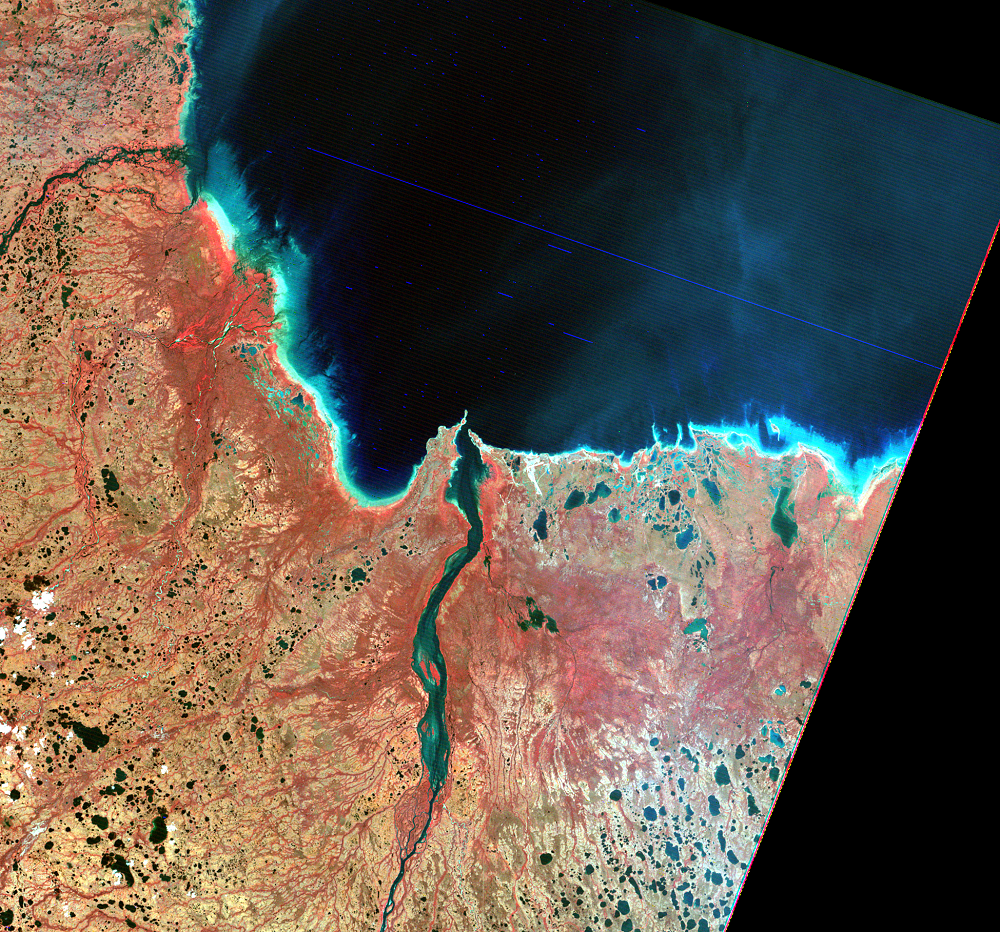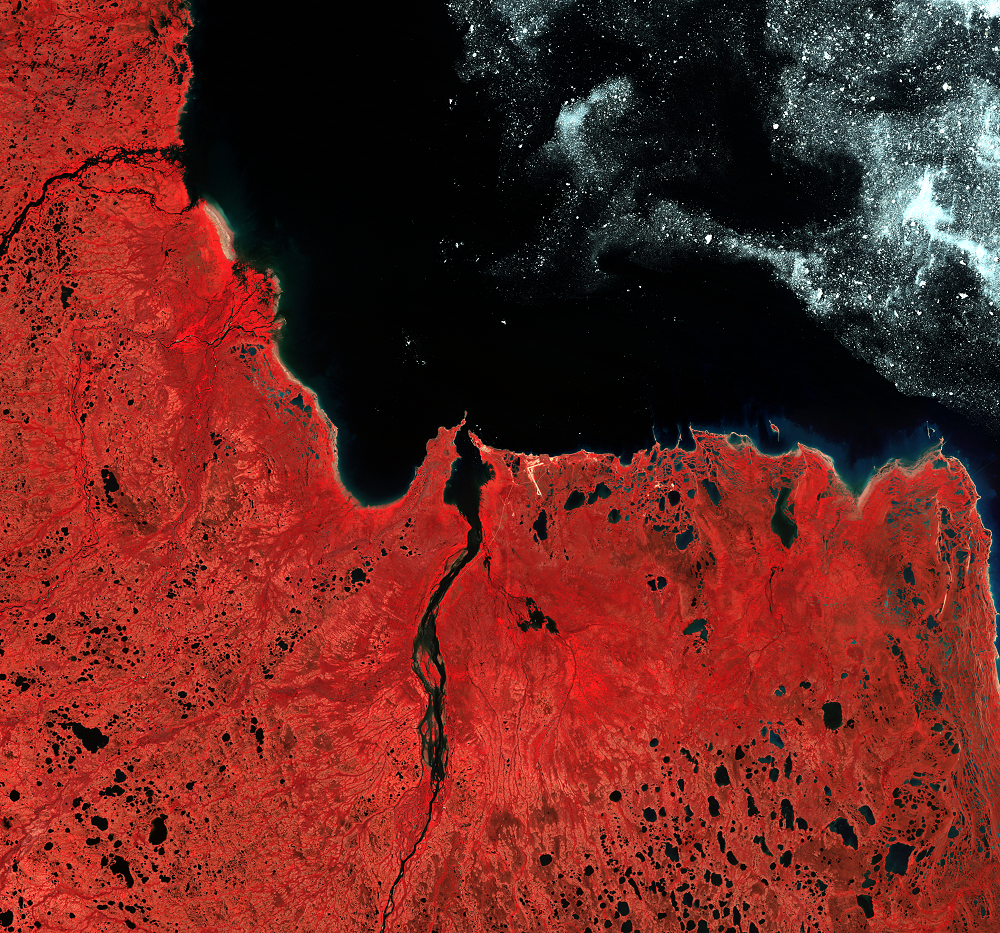
Knife River Delta, Canada
Earth Resources Observation and Science (EROS) Center - Earthshots
These images show devegetated shoreline along Hudson Bay in central Canada, eaten bare by growing numbers of snow geese. In the Landsat images, red signifies vegetation. Hudson Bay appears black in the upper-right of the images, and north of the Knife River Delta is a bright strip of land eaten bare by the geese.
These Mid-Continent snow geese live in coastal marshes along the Gulf of Mexico in winter and along Hudson Bay in summer. They spend almost all spring and fall migrating back and forth. Their traditional winter diet is marsh hay cordgrass, saltgrass, bulrush, and other marsh plants. Snow geese are not only grazers but also grubbers, digging up even the underground parts of plants with their strong bills.
In the spring, the snow geese fly north along well-defined paths through the prairies, stopping often to eat along the way. They linger on the prairies of the northern United States and southern Canada until about early May, then fly nonstop across the northern forests to coastal areas around Hudson Bay and farther north.
Once at the nesting ground, they start breeding. The northern summer is just long enough for goslings to hatch and learn to fly. Female snow geese have strong homing habits, returning to the spot where they were raised and even using their previous nest sites. Snow geese form large colonies of a few hundred to over 100,000 birds. Nearby La Perouse Bay (marked on this map) has the best-known colony in the world, studied by scientists since 1968.
Up in the tundra, summer is short and the soil is shallow and dry. Nesting snow geese seek out the lusher "oases" in this arctic "desert," narrow productive strips of a few hundred yards along the Bay and along some inland lakes. But even here food is sparse, since the geese leave just as the growing season is ending, with no time for the plants to recover before the next spring.
So even in a good summer, the females rely on stored energy in their bodies to produce and incubate their eggs. To produce a large clutch of eggs, they need to arrive at Hudson Bay fat and healthy. So traditionally, the amount of food available during winter and spring acted as one of the limits on the snow goose population.
European settlement brought good times for snow geese, as the Louisiana-Manitoba corridor became one long buffet line for them. By the mid-1900s degradation and draining of the Gulf Coast marshes pushed many snow geese inland, where they learned to feed on the stubble and seeds of wheat, corn, and especially rice fields. There were rice farmers in Texas who suddenly went from having no geese to flocks of thousands in the late 1940s. As Midwestern agriculture intensified, some birds stopped going to the coast, instead wintering as far north as Iowa.
This southern "gravy train" improved the snow geese's winter survival rates and springtime weight gain. Fatter, more numerous females then produced more goslings. The young flying south for the first time found more food along the way. Flocks inevitably grew; in 25 years the Mid-Continent population increased from about 2 million to 5 million birds. The colony at La Perouse Bay grew from 2,000 nesting pairs in 1968 to 22,500 in 1990.
Imagery
Downloads
Alisauskas, R.T., and Ankney, C.D., 1992, Spring Habitat Use and Diets of Midcontinent Adult Lesser Snow Geese: Journal of Wildlife Management, v. 56, no. 1, p. 43–54.
Batt, B., 1998, A Perilous Abundance: Ducks Unlimited, Jan/Feb, p. 56–58.
Batt, B., 1998, U.S., Canada may declare war on geese: USA Today, Apr. 28, 1998, p.59.
Bihrle, C., 1998, Greater Goose Harvest—Higher Limits, Periodic All-Day Hunting Create Possibilities: North Dakota Outdoors, Sept/Oct 1998.
Cooke, F., Rockwell, R.F., and Lank, D.B., 1995, The Snow Geese of La Perouse Bay: New York, Oxford University Press, 320 p.
Drew, L., and Madson, C., 1997, Out of Control! Exploding numbers of snow geese are bad news for Midwest farmers and an entire Far North ecosystem: National Wildlife, available online at https://www.nwf.org/en/Magazines/National-Wildlife/1998/Out-of-Control. (Accessed February 3, 2012.)
Jano, A.P., Jefferies, R.L., and Rockwell, R.F., 1998, The Detection of Vegetational Change by Multitemporal Analysis of LANDSAT Data: The Effects of Goose Foraging: Journal of Ecology, v. 86, no. 1, p. 93–99.
Jano, A.P., 1998, Habitat Loss Assessment by Multispectral Analysis of Landsat Data in the Seal-Knife River Region [poster], presentation at North American Arctic Goose Conference 1998, Victoria, British Columbia, 7–11 January 1998.
Madson, C., 1997, Snow Drifts—The Mid-Continent's Lesser Snow Geese: Wildfowl Magazine, April/May, p. 48–49.
Tompkins, S., 1999, Snow geese debate heating up, but there's no solution in sight: Houston Chronicle, Feb. 4, 1999, p. 11.
Thanks to Andrew P. Jano, Ontario Ministry of Natural Resources, for his assistance.



